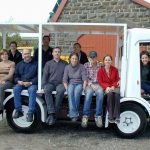Reposted from original article from the ABC News
Newstead is a town with big renewable energy ambitions, which include the replacement of an old petrol station with an electric charging station.
The small community of 500, located 140 kilometres north-west of Melbourne wants all of their power to come from renewable energy sources in five years’ time.
Mick Harris, who runs the new environmental store in town, is in full support.
He has installed a medium-sized electric vehicle charge station in the old petrol bowser at his business as a way of moving away from the “older systems” to the “new renewable systems”.
“We believe that electric vehicles are part of the future and we believe it’s important to start to provide the resources that these kind of vehicles need,” Mr Harris said.
But he said the decision was also economic, with the financial challenges of running a small petrol station in the country difficult.
He said he would have liked to provide a mixed service of both petrol and electric but found the petrol station tanks too small and delivery costs too high.
“When you’re a small operator and you’re up against the big chains of petrol stations, it makes it quite difficult to make the numbers add up,” Mr Harris said.
Gradual take up of electric cars

Mr Harris said there were more electric vehicles coming into the community all the time.
“While it will be a gradual process, we think it’s a process that’s not going to stop and people need somewhere to charge up their vehicles so we’re happy to provide that service,” he said.
According to the Federal Chamber of Automotive Industries, last year there were 1,108 electric and 12,138 hybrid electric vehicles sold in Australia.
These figures were up from 2011 when 49 electric and 8,820 electric hybrid vehicles were sold.
But these figures are still small compared to the annual car sales figure of over 1 million in 2015.
How does it work?

Mr Harris takes great amusement in the fact the electric charging station was installed in the old petrol bowser.
He said it was a useful piece of infrastructure with an existing stand and built-in lights, with only an upgrade of the existing power line needed.
“This is a useful way to recycle, repurpose the pump and get some value from it,” Mr Harris said.
The medium power unit is more powerful than a domestic unit.
The 16 amp charger will be upgraded to three-phase electrical power in a few months and it is expected a car can travel for about 100 kilometres after four hours of charging.
Costing about $1,500 to install, the current charger takes about eight hours to charge the same distance.
The service is free for people to use.
“Anyone who owns an electric vehicle knows one of the great advantages of electric vehicles is that they don’t cost a great deal to charge up,” Mr Harris said.
“And when they don’t cost a great deal to charge up, it means we can give away the electricity.”

Filmmaker from nearby Fryerstown, Davide Michielin, decided to buy an electric vehicle in an effort to become carbon neutral.
He bought the Tesla Model S after finding nothing on the market could provide him with the 400 kilometre range he required for his long distance commuting.
“It was certainly more expensive than my ute but it had multiple functions … and it looked pretty good,” Mr Michielin said.
He currently charges his car overnight at home and at a Supercharger station in Melbourne but will now use the station in Newstead.
There are currently about 90 public charge stations throughout Victoria with most of them located closer to Melbourne.
Central Victoria has two stations in Bendigo, one in Fernihurst and now Newstead with none in western Victoria.
Newstead’s long history with electric vehicles

Mr Harris has had a long relationship with electric vehicles, dating from way back in the 1970s.
He is the proud owner of an old British electric milk truck built in the 1960s to replace the horse and cart system of milk delivery.
“It was a great solution because it was easy to stop and start, it would carry a lot of weight, it didn’t have to go very fast and it was a very simple robust technology,” Mr Harris said.
About three trucks wound up in Melbourne in the 1970s as part of a project to test the vehicles as replacements for horse and cart milk delivery there.
After the project finished, the vehicles were sold off with Mr Harris one of the successful buyers.
“Then I thought, what greater place to take an electric milk truck than Newstead — makes total sense,” he said.
Mr Harris uses it predominantly on site to transport goods around and jokes that he plans to race the Tesla.
Travelling at 25km/hr, it will be quite a challenge — the Tesla can travel at speeds of up to 200km/hr.










